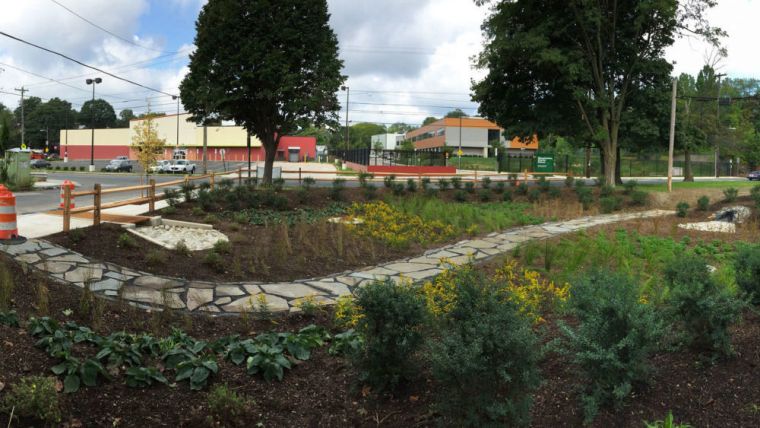PHILADELPHIA’S BOLD PLAN: Green City, Clean Waters – an inter-generational commitment to “optimize and engineer the landscape” to mimic and restore its natural hydrologic regime!
Note to Reader:
In a major initiative, Philadelphia is building an extensive network of rain gardens, green roofs, wetlands, and other infrastructure to capture rainwater and stormwater runoff. The goal is to prevent runoff from overwhelming sewers and polluting waterways and to help green America’s fifth-largest city.
In March 2018, the Yale School of Forestry and Environmental Studies published a comprehensive article by Bruce Stutz that is titled With a Green Makeover, Philadelphia Is Tackling Its Stormwater Problem. Excerpts are reproduced below. CLICK ON THE IMAGE BELOW.
Philadelphia Innovates on Green Infrastructure
“Instead of building more and bigger sewers and related infrastructure, Philadelphia has adopted a relatively new paradigm for urban stormwater: Rather than convey it, detain it — recreate in the urban streetscape the kinds of pervious places where, instead of running into surrounding waterways, rainfall and the contaminants it carries can once again soak into the earth,” wrote Bruce Stutz.
To Learn More:
To read the completer article, download With a Green Makeover, Philadelphia Is Tackling Its Stormwater Problem
Also, for historical context, visit FLASHBACK TO 2010: Philadelphia Urban Water Leadership Conference represents a “watershed moment” in the United States because it linked green infrastructure practices to water sustainability outcomes
Green City, Clean Waters
“The Philadelphia Water Department has taken the lead in the project through its Green City, Clean Waters initiative,” continued Bruce Stutz.
‘In six years, the Water Department, collaborating with environmental groups and civic associations, has completed 152 publicly funded green stormwater infrastructure projects. Some 300 more are in the works in schools, parking lots, parks, and on rooftops.
“But green acres on public property alone — at an estimated cost of $US 250,000 to $US 300,000 for each greened acre — won’t get the city to its 25-year goal of 10,000 greened acres. That will require a great deal of private green infrastructure.”
Re-Imagining the Urban Landscape
 Nancy Stoner was influential in developing Philadelphia’s green stormwater initiative in her former roles at the Natural Resources Defense Council’s water program and the EPA’s Office of Planning and Policy Analysis. The program was never solely about slashing combined sewer overflow, she recalls, but also about providing larger environmental and social benefits.
Nancy Stoner was influential in developing Philadelphia’s green stormwater initiative in her former roles at the Natural Resources Defense Council’s water program and the EPA’s Office of Planning and Policy Analysis. The program was never solely about slashing combined sewer overflow, she recalls, but also about providing larger environmental and social benefits.
“Philadelphia wanted to do much more,” Stoner says. “They did a benefits analysis before they began that showed it would enhance air quality and climate resiliency. It takes the problem of stormwater and turns it into an amenity.”

A rain garden manages stormwater runoff in Philadelphia’s Germantown section. PHILADELPHIA WATER DEPARTMENT
Howard Neukrug’s Plan to Water Down Philadelphia
When he was appointed Water Commissioner in 2011, Howard Neukrug focused on making the Philadelphia Water Department a sustainable 21st Century urban water utility – one that would fully meet the complex responsibilities and opportunities of our time and our environment. He retired as Commissioner in February 2016.
 Prior to that, Howard Neukrug began Philadelphia’s Office of Watersheds in 1999. As director, he led the department in creating the vision and the plan for Green City, Clean Waters, Philadelphia’s long term plan to clean up the city’s waterways.
Prior to that, Howard Neukrug began Philadelphia’s Office of Watersheds in 1999. As director, he led the department in creating the vision and the plan for Green City, Clean Waters, Philadelphia’s long term plan to clean up the city’s waterways.
Howard Neukrug fundamentally changed Philadelphia’s relationship with nature, and other cities are watching with great interest, wrote Pascal Mittermaier in the introduction to his interview of Howard Neukrug, published in the Huffington Post. “When I met with urban planners in China and in Mexico, reports about Neukrug’s work were sitting on their desks,” stated Mittermaier.
To Learn More:
Download “Green City, Clean Waters”: An Interview with Philadelphia’s Howard Neukrug to read the complete interview by Pascal Mittermaier in the Huffington Post.

from a presentation by Howard Neukrug in 2010
An Inter-Generational Time Frame
“A key aspect of Philadelphia’s green stormwater infrastructure plan is the realization that it will take decades to turn the situation around and re-establish some semblance of ecological balance in the way this city of 1.6 million handles rainfall,” observed Bruce Stutz in his article.
“The city is working now to standardize the construction of green infrastructure and monitor its effectiveness. Costs are coming down as green infrastructure becomes more widely adopted.
“The Water Department’s website map is crowded with green infrastructure sites across the city. But a thousand green acres means the city is only about a tenth of the way toward its goal,” concluded Bruce Stutz.



